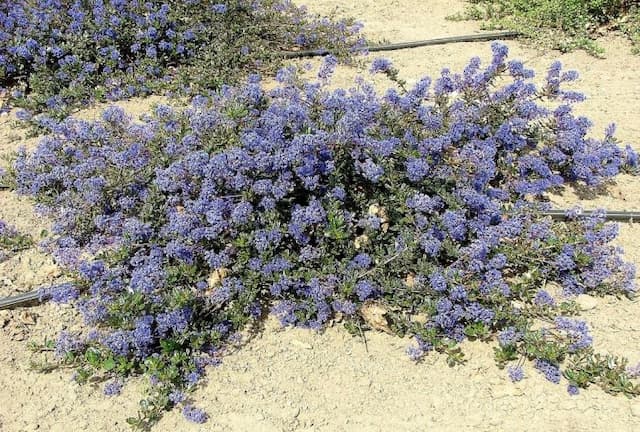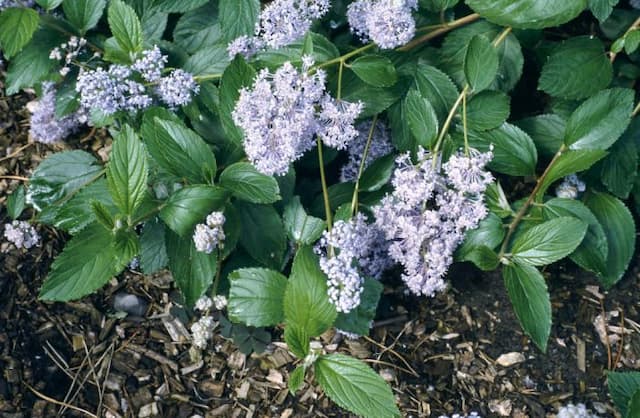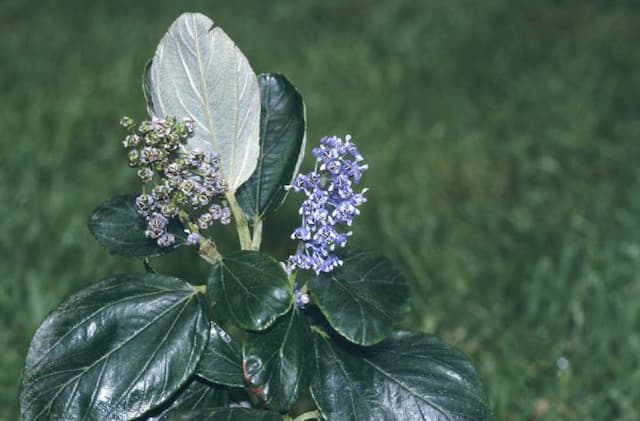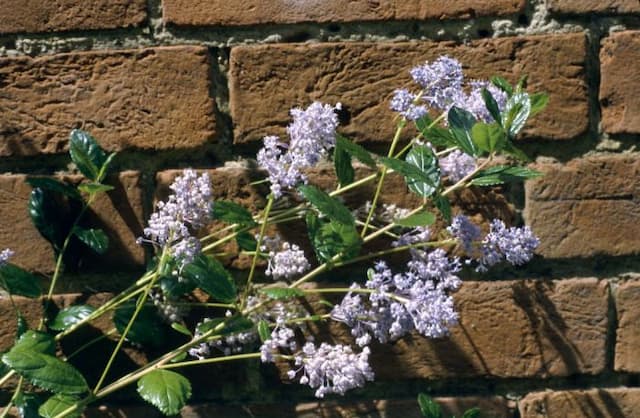California Lilac Ceanothus 'Lemon and Lime' (PBR)

ABOUT
The Ceanothus 'Lemon and Lime', commonly known as the California lilac, showcases a vibrant foliage that is particularly striking due to its color contrast. This evergreen shrub is named for the bright yellow hue of its new leaves, which mature to a lime green, offering a refreshing and cheerful display throughout the year. The California lilac is adorned with small, delicate flowers that bloom abundantly. These blossoms are typically of a rich blue tone, creating a striking contrast against the lemon and lime-colored leaves. The flowers are arranged in dense clusters that cover the plant, providing not only a visual spectacle but also a haven for pollinators like bees and butterflies. The leaves of the California lilac are small to medium in size and have a glossy texture which further accentuates their color. They are quite dense, giving the plant a lush and full appearance. The plant's overall form is gracefully rounded, providing a soft, yet structured, presence in the garden. The California lilac is robust and low-maintenance, with a nature that allows it to thrive in a variety of conditions, although it prefers a sunny spot. Thanks to its vibrant colors and amiable shape, it is often used as a focal point in landscape designs, and can also be implemented in mixed borders or as part of a hedging scheme. The beauty of the California lilac is that, while it is visually stunning throughout the blooming season, its foliage ensures that it remains an attractive feature throughout the year.
About this plant
 Names
NamesFamily
Rhamnaceae
Synonyms
Lemon And Lime Ceanothus, Variegated California Lilac
Common names
Ceanothus 'Lemon and Lime' (PBR)
 Toxicity
ToxicityTo humans
California Lilac is generally not considered toxic to humans. There is limited information available on severe toxic reactions from ingestion. However, as with any plant, individual allergies or sensitivities could occur, causing mild symptoms such as stomach upset or skin irritation.
To pets
California Lilac is not commonly known to be toxic to pets either. While not typically causing severe reactions, ingestion could lead to mild gastrointestinal upset in some animals. If a pet appears unwell after consuming any part of the plant, it is advisable to consult a veterinarian.
 Characteristics
CharacteristicsLife cycle
Perennials
Foliage type
Evergreen
Color of leaves
Variegated
Flower color
Blue
Height
5 feet [1.5 meters]
Spread
6 feet [1.8 meters]
Plant type
Shrub
Hardiness zones
7
Native area
North America
Benefits
 General Benefits
General Benefits- Attracts Pollinators: Ceanothus 'Lemon and Lime' is known to attract bees, butterflies, and other pollinating insects, benefiting the biodiversity in your garden.
- Low Maintenance: This variety of California Lilac is relatively easy to care for, requiring minimal pruning and maintenance once established.
- Drought Tolerance: The California Lilac is drought-resistant, making it an excellent choice for water-efficient landscaping.
- Year-Round Interest: With its bright, lime-green foliage and contrasting blue flowers, it provides visual interest throughout the seasons.
- Fast Growth: It grows relatively quickly, which is great for gardeners looking to establish a mature garden in a shorter period.
- Erosion Control: Its dense growth habit can help to stabilize soil and prevent erosion on slopes or banks.
- Wildlife Habitat: Provides natural shelter and nesting sites for birds and beneficial insects.
- Landscape Versatility: Works well in various garden designs, including borders, hedges, and as a stand-alone focal point.
- Evergreen: As an evergreen shrub, it retains its leaves throughout the year, ensuring continuous coverage and greenery.
 Medical Properties
Medical PropertiesThis plant is not used for medical purposes.
 Air-purifying Qualities
Air-purifying QualitiesThis plant is not specifically known for air purifying qualities.
 Other Uses
Other Uses- Privacy Screening: Ceanothus 'Lemon and Lime', commonly known as California lilac, can be utilized as a natural privacy screen due to its dense foliage when planted in a row or hedge.
- Natural Dye Source: The leaves of California lilac can be used to extract natural dye for textile coloring, offering shades of green depending on the mordant used.
- Erosion Control: With its robust root system, California lilac is excellent for stabilizing hillsides and slopes, preventing soil erosion especially in dry areas.
- Lawn Alternative: Low-growing varieties of California lilac can serve as a drought-resistant alternative to traditional grass lawns.
- Garden Sculpture: Trained and pruned carefully over time, California lilac can be shaped into creative topiary forms, adding a unique sculptural element to gardens.
- Insect Habitat: The dense branches and foliage of California lilac provide shelter and breeding sites for beneficial insects such as ladybugs and lacewings.
- Garden Themed Events: Due to its vibrant foliage, California lilac is often used as a backdrop for garden weddings and other outdoor events, enhancing the aesthetic of the setting.
- Landscape Themes: California lilac can be used to create a coastal garden theme, its native habitat, complementing other seaside plants in landscape designs.
- Photography: The attractive contrast of the 'Lemon and Lime' foliage against its blue flowers makes California lilac a popular subject for garden photography enthusiasts.
- Living Fence: Dwarf varieties of California lilac can be planted close together to form a 'living fence', providing a more natural and sustainable boundary than traditional fencing materials.
Interesting Facts
 Feng Shui
Feng ShuiThe California lilac is not used in Feng Shui practice.
 Zodiac Sign Compitability
Zodiac Sign CompitabilityThe California lilac is not used in astrology practice.
 Plant Symbolism
Plant Symbolism- Renaissance: Ceanothus, also known as California lilac, often symbolizes rejuvenation and renewal, much like the rebirth of culture during the Renaissance period.
- Hope: The bright and vibrant bloom of the California lilac can represent hope and optimism, suggesting the arrival of better times ahead.
- Patience: As some species of Ceanothus take time to establish and bloom profusely, they are sometimes associated with the virtue of patience and the rewards it brings.
- Patriotism: The California lilac is native to North America, and its blue flowers are sometimes used to symbolize American patriotism, especially in the Western states where it commonly grows.
- Survival: Ceanothus is known for its hardiness and ability to survive in drought-prone areas, representing the strength and resilience to withstand tough conditions.
 Water
WaterThe California Lilac requires moderate watering. During its growing season in spring and summer, water the plant once a week with about one to two gallons of water per session, depending on the size of the plant and the climate. In the fall and winter, reduce watering to every two weeks, ensuring that the soil dries out between waterings to prevent root rot. Always check the top two inches of soil for dryness before watering. Overwatering can be detrimental, so ensure good drainage.
 Light
LightThe California Lilac thrives in full sun to light shade. It prefers a location where it gets at least six hours of sunlight daily. Avoid overly shaded spots as this can reduce blooming and lead to leggy growth. A spot that receives morning sun and light, dappled shade in the afternoon is ideal.
 Temperature
TemperatureCalifornia Lilacs are hardy and can tolerate a range of temperatures. They can survive in temperatures as low as 10 to 15 degrees Fahrenheit, but they thrive in areas where the temperature ranges between 60 and 75 degrees Fahrenheit. Exposure to temperatures below 10 degrees Fahrenheit may damage or kill the plant.
 Pruning
PruningPruning the California Lilac is important for maintaining its shape and promoting healthy growth. Prune it immediately after flowering, typically in late spring or early summer, to remove spent flowers and to shape the plant. Avoid heavy pruning; instead, lightly thin out crowded branches to improve air circulation.
 Cleaning
CleaningAs needed
 Soil
SoilThe California Lilac 'Lemon and Lime' thrives in well-draining, fertile soil with a ph between 6.0 and 8.0. A soil mix of loamy or sandy composition is ideal, amended with some organic matter to provide nutrients. To create the best soil mix, combine two parts loam or sand, one part peat or well-rotted compost, and one part perlite or pumice for increased aeration and drainage.
 Repotting
RepottingCalifornia Lilac 'Lemon and Lime' should be repotted every 2 to 3 years to prevent root bounding and to replenish the soil. Care should be taken when repotting as they have a sensitive root system. Opt for a slightly larger pot each time to ensure adequate space for growth.
 Humidity & Misting
Humidity & MistingCalifornia Lilac 'Lemon and Lime' is tolerant of a range of humidity levels but prefers moderate conditions. Aiming for a relative humidity of around 40-50% is ideal for this plant. It's hardy and can adapt to the humidity levels typically found in most outdoor environments.
 Suitable locations
Suitable locationsIndoor
Place in a bright, airy spot, avoid excess humidity and heat.
Outdoor
Choose sunny spot, protect from harsh winter cold.
Hardiness zone
7-10 USDA
 Life cycle
Life cycleThe California Lilac 'Lemon and Lime' (Ceanothus) begins its life as a seed, which germinates in late winter or spring when conditions are moist and temperatures are mild. The seedling stage involves the development of the plant's initial roots and shoots as it begins to photosynthesize and grow. As it matures into a young plant, the Ceanothus 'Lemon and Lime' develops a woody stem and distinctive variegated foliage, with lush green leaves edged in creamy yellow. During the flowering stage, typically in late spring, it produces clusters of aromatic, blue or purple flowers that attract pollinators such as bees and butterflies. After pollination, the plant sets seed, developing small, hard fruit that disperse for the next generation. Lastly, as a perennial shrub, it enters a period of dormancy in the winter, where growth slows down before the next growth cycle starts.
 Propogation
PropogationPropogation time
Spring-Early Summer
The most popular method for propagating Ceanothus 'Lemon and Lime', commonly referred to as California Lilac, is through semi-hardwood cuttings. This process involves taking cuttings from the plant during the late summer, when the current year's growth has started to mature and become semi-woody. Cuttings should be about 4 to 6 inches (about 10 to 15 centimeters) long and include several leaves. The lower leaves are removed, and the cut end may be dipped in rooting hormone to encourage root development. The cutting is then inserted into a pot filled with a well-draining potting mix, ensuring that the remaining leaves are not buried. The pot is kept in a warm location with indirect sunlight and the soil is kept moist, but not wet, to prevent rot. Roots typically emerge within several weeks, and once well-established, the new plant can be transplanted into the garden.









